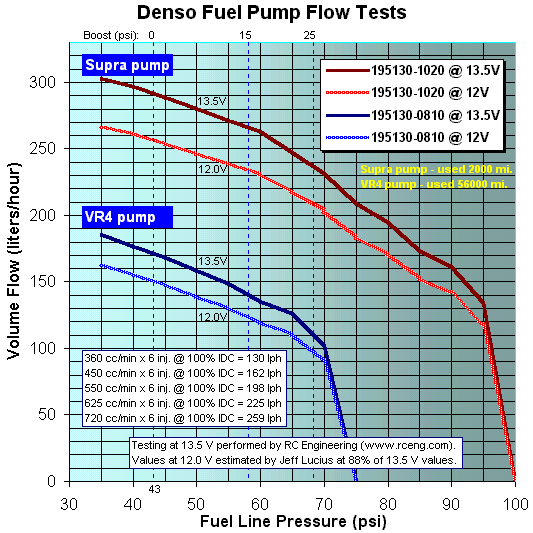Fuel Pump Flow Tests
by Jeff Lucius
The fuel pump used in the Mitsubishi 3000GT and Dodge Stealth is a constant- or fixed-displacement pump. A fixed volume of fuel is delivered for every revolution of the pump. The amount of fuel delivered is determined by how fast the pump rotates. The pump will rotate faster if the supplied voltage is increased and if the line pressure is reduced.
Fuel pump performance is determined by the volume or mass of fuel pumped over a range of fuel line pressures at a fixed voltage. Fuel pumps supply fuel volume; they do not create pressure in the fuel lines. In a return-line system (like in the Stealth and 3000GT), the fuel pressure regulator restricts the return fuel flow and it is this that creates pressure in the supply lines. As fuel supply-line pressure increases, such as during boost conditions for forced-induction engines, the pump has to work harder (it actually rotates slower) and so the volume flow decreases. Pumps also have a ceiling capacity where flow drops off rapidly above a certain line pressure. The flow rate is measured in gallons per hour (gph), liters per hour (lph; 1 gallon = 3.7854 L), or pounds per hour (lb/hr). The average density of gasoline is 690 to 760 g/L (or 5.76 to 6.34 lb/gal).
The chart below shows the flow test results for the stock Mitsubishi VR4 and the Toyota Supra Turbo fuel pumps. Both pumps are used (about 56,000 miles on my original Stealth TT pump and about 2,000 miles on the mail-order Denso pump). RC Engineering, Inc. (Torrance, CA; 310-320-2277) performs these tests using a pump dynamometer (this service costs about $50 per pump). Testing was performed on March 28, 2001 with a pump supply voltage of 13.5 volts. The test fluid specific gravity was 0.76 (or 6.34 lb/gal). The Denso pump with part number 195130-1020 (used in the stock Toyota Supra Turbo) clearly outperforms the stock VR4 pump (Denso 195130-0810). The Supra pump is an excellent upgrade choice for Dodge Stealths and Mitsubishi 3000GTs.

I added to the chart the theoretical maximum-flow capabilites of popular fuel injectors for the VR4. Please note that most injector manufacturers recommend a maximum, continuous injector duty cycle (IDC) of 80 percent, and that peak injector output often occurs at only 90 to 95 percent IDC. I also estimated pump output at a reduced voltage. Under most operating conditions (with the notable exception of idle in VR4s), the fuel pump should receive the full voltage output of the alternator minus small transmission losses along the wires. The VR4 alternator in good operating condition tries to maintain at least 13.4 volts at ambient temperatures under 140ºF (60ºC).
The chart points out the limits of the stock VR4 fuel pump (at least a used one with 56000 miles on it) with the stock VR4 360 cc/min injectors. Above 20 psi boost (63 psi line pressure) the pump operating at 13.5 V cannot supply enough fuel for the injectors. At 12 volts the pump runs out of capacity below 15 psi. Boost pressures of 14 to 15 psi are widely considered the safe limit (if detonation is controlled) for a 3000GT VR4 or Stealth TT with a stock fuel system (regardless of which turbo is used).
The Supra pump at 13.5 volts flows sufficient fuel at line pressures up to 68 psi (25 psi boost) to supply six injectors with any size up to 625 cc/min. At 12 volts, the Supra pump is completely adequate for 550 cc/min injectors. If you are using injectors that are larger than 550 cc/min, then you should consider a pump with a higher capacity, such as one rated at 340 lph, or perhaps even dual pumps and larger supply and return lines.
Page last updated March 17, 2002.

